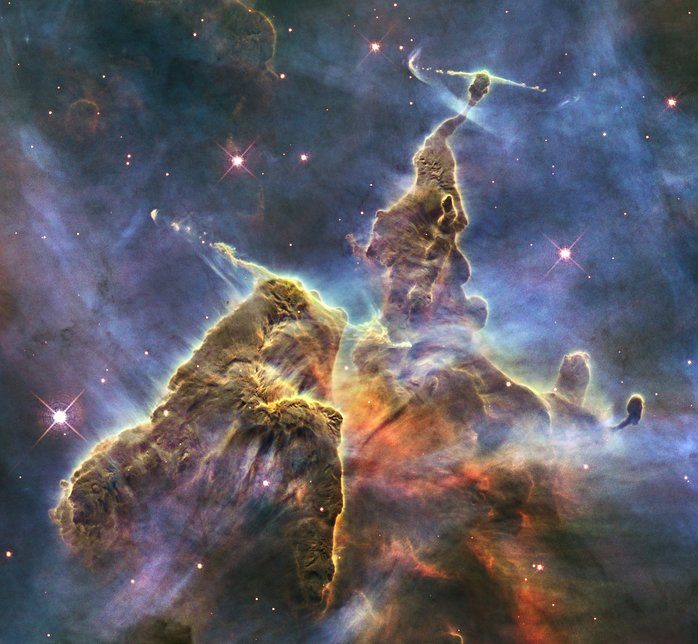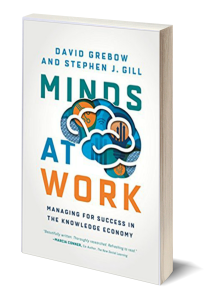
This turbulent cosmic pinnacle lies within a tempestuous stellar nursery called the Carina Nebula, located 7500 light-years away in the southern constellation of Carina.
Scorching radiation and fast winds (streams of charged particles) from super-hot newborn stars in the nebula are shaping and compressing the pillar, causing new stars to form within it. Streamers of hot ionised gas can be seen flowing off the ridges of the structure, and wispy veils of gas and dust, illuminated by starlight, float around its towering peaks. The denser parts of the pillar are resisting being eroded by radiation.
Nestled inside this dense mountain are fledgling stars. Long streamers of gas jets can be seen shooting in opposite directions from the pedestal at the top of the image. These jets are signposts for new star birth and are launched by swirling gas and dust discs around the young stars, which allow material to slowly accrete onto the stellar surfaces.
I love this image. It is all about new beginnings …
I’ve been writing this blog for such a long time that I became too familiar with the old look and feel. Until now. When I started these posts, I was just starting to scratch the surface of how technology could change the ways we learn. As one of my friends like to say, “Since Moby Dick was a minnow.” I have always been fascinated by how technology could enable, empower, and enhance the ways we learn.
I started before most of the educational technology we now have even existed. CD-ROMs had been replaced by Internet-driven online learning that was still new and being explored and evaluated. Formal learning in a classroom with a sage-on-the-stage was still the default and smile sheets continued to be the way the learning was assessed. LMS were just starting to be used to manage classrooms and the new online programs, and informal learning was still just a really bad idea. Some things changed, yet it feels like most of what we were doing then is what we are doing today.
So, what have I learned in all this time? Two important lessons.
First, learning as a natural human process has not changed in thousands of years. I’m still in awe of how we take in, remember, forget, and use what we learn. And no one, despite all the theories and ideas about education, has any real understanding of the process. Some theories and assumptions, many good guesses, lots of practical observations. And learning is still a wondrous mystery.
At the Inflection Point
Second, we are at the most dramatic inflection point in the history of work, and the implications for management and learning are profound.
We have come through two very different economic eras, each with a specific and different way of managing people and helping them learn to do their jobs. We are entering the third, and it is unlike anything that has ever come before. The first two periods – Agricultural driven by land, and Industrial driven by things – were labor-intensive. We produced work with our hands and learned to manage hands. Jobs were not as complex or constantly changing and we had time to learn, to take what we knew from school, or one job to another, and learn as we worked.
As we enter this newest period of history, driven by Knowledge, most of us produce work with our minds. The need to be an adept continual learner has become part of every job description. Technology has become an indispensable tool for the ways we learn.
If I could see all of you reading this post at this moment I would ask you the following question: How many of you produce work with your hands? I know that not many of your hands would go up. If I asked this question fifty years ago, when many people still worked with their hands, I would see 30-40% of the hands raised. In any audience one hundred years, ago almost every hand would be raised since just about everyone worked with their hands.
We measure our lives in tens of years not hundreds, so it feels like one hundred years is far away and long ago. In the span of history, it’s a barely a blink. And in this blink, most of the people on this planet have switched from producing work with their hands to producing work with their minds. That is new and has never happened before. Until recently it was a gradual evolution not a revolution. So, we have reached a profound inflection point in the history of work. The future is now all about learning how to manage minds.
Driving Forward Looking in the Rearview Mirror
The problem is that too many organizations are still acting as if we have not reached the inflection point. Their organizational structures and approaches to management and learning are disabling instead of enabling people to be successful. They are mired in a way of doing business that was developed when we were managing hands. What they are experiencing are a myriad of symptoms that are a result of trying to meet 21st century challenges with 20th century solutions. It does not work and there are enough companies in this century that have ended up in the Business Boneyard to prove the point. Either you evolve or you perish.
The implications are staggering and far-reaching, and that is what I will be writing about in this blog, and what I covered in my new book. If your future has anything to do with managing people, or enabling and empowering then to learn and grow professionally and personally, I recommend that you read what I discovered about how organizations are successfully learning to manage minds and thrive in the future. The research introduced me to some of the most forward-looking, smart and successful companies around the world who are quickly becoming models for what needs to be done.
The book Minds at Work, co-authored with Stephen J. Gill, can be pre-ordered on Amazon and at other web bookstores.
And thank you to all of the many loyal readers who have been with me for any part of this learning journey. It will only get more interesting from here onward.
